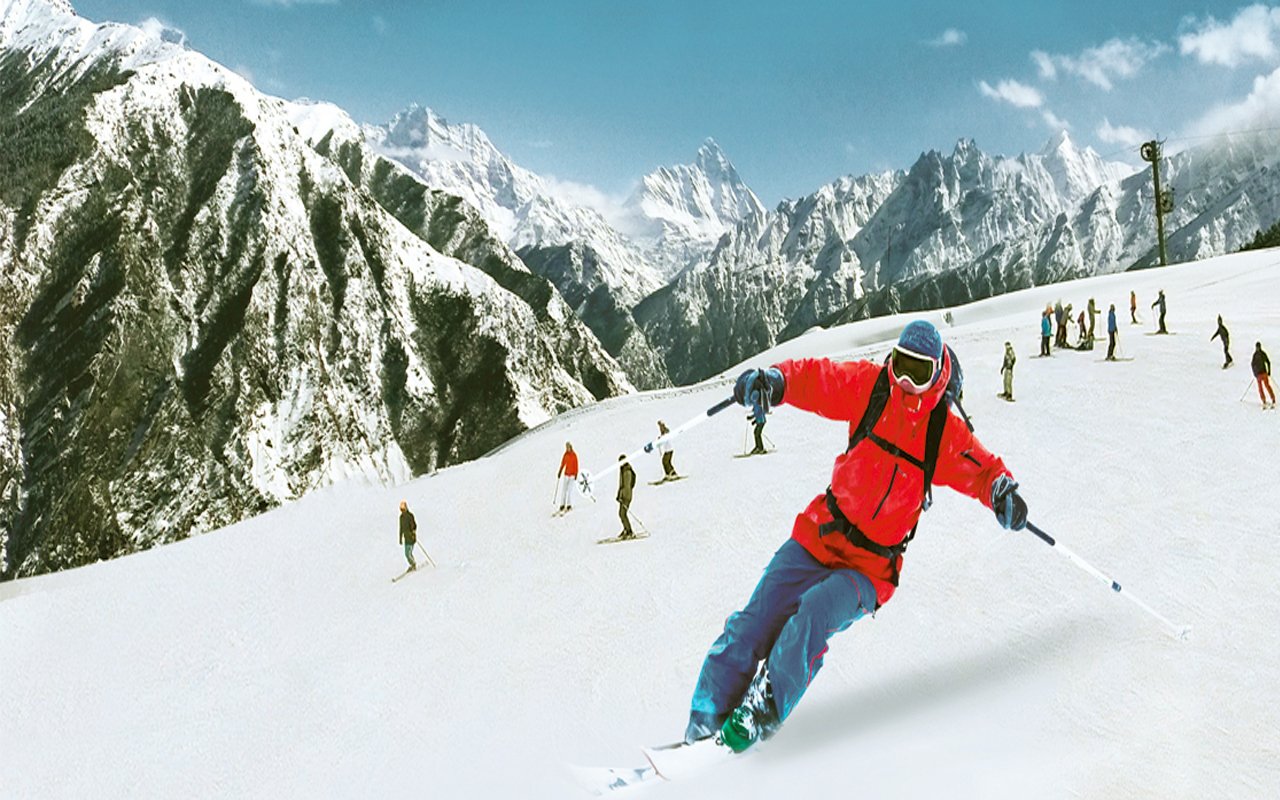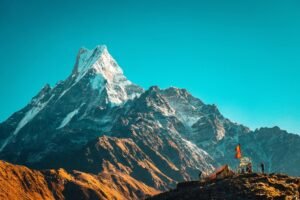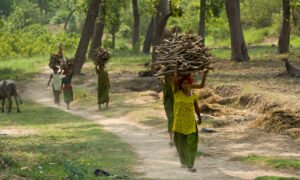The Himalayas, often called the “abode of snow,” offer some of the most stunning and challenging skiing and snowboarding opportunities in the world. Stretching across five countries – Bhutan, India, Nepal, China, and Pakistan – the Himalayas boast majestic peaks, pristine snow, and a variety of terrains that attract winter sports enthusiasts from around the globe. This article explores the best destinations, tips for preparation, safety measures, cultural aspects, and the importance of sustainable tourism while skiing and snowboarding in the Himalayas.
The Himalayan Skiing and Snowboarding Experience
Skiing and snowboarding in the Himalayas offer a unique blend of thrilling adventure and breathtaking natural beauty. The region’s vast and varied terrain includes everything from gentle slopes suitable for beginners to steep, powdery descents that challenge even the most experienced riders. The remote and pristine nature of the Himalayas provides an unparalleled sense of adventure and solitude.
Top Destinations
1. Gulmarg, India
Gulmarg, located in the Indian state of Jammu and Kashmir, is one of the most famous skiing destinations in the Himalayas. Known for its powder snow and stunning views of the surrounding peaks, Gulmarg boasts the world’s highest ski lift, the Gulmarg Gondola, which reaches an altitude of 3,980 meters. The area offers a mix of terrains, from beginner slopes to challenging off-piste runs.
Attractions in Gulmarg
Gulmarg Gondola: The second-highest operating cable car in the world, offering breathtaking views and access to high-altitude skiing.
Apharwat Peak: Known for deep powder and long descents, it’s a favorite among advanced skiers and snowboarders.
Khilanmarg: A picturesque valley offering gentle slopes perfect for beginners and intermediate skiers.
2. Auli, India
Auli, situated in the state of Uttarakhand, is another popular skiing destination in India. With its well-maintained slopes and modern facilities, Auli is ideal for both beginners and advanced skiers. The panoramic views of Nanda Devi and other towering peaks make skiing here an unforgettable experience.
Attractions in Auli
Artificial Lake: One of the highest man-made lakes in the world, used to create artificial snow for the slopes.
Skiing Events: Hosts national and international skiing competitions, making it a vibrant place for winter sports enthusiasts.
Auli Ropeway: One of the longest ropeways in Asia, providing stunning views and easy access to the skiing slopes.
3. Solang Valley, India
Located near Manali in Himachal Pradesh, Solang Valley is renowned for its picturesque setting and excellent skiing conditions. The valley offers a range of slopes suitable for all levels of skiers and snowboarders. Additionally, Solang Valley is a hub for winter sports and adventure activities, including paragliding and zorbing.
Attractions in Solang Valley
Solang Ropeway: Provides a bird’s-eye view of the valley and easy access to higher slopes.
Adventure Activities: Apart from skiing, the valley offers snowmobiling, paragliding, and tubing.
Snow Carnival: An annual event featuring skiing competitions, cultural performances, and local cuisine.
4. Phobjikha Valley, Bhutan
Phobjikha Valley, also known as Gangtey Valley, is one of the few places in Bhutan where skiing is available. This serene and remote location offers cross-country skiing and a chance to experience Bhutan’s unique culture and natural beauty.
Attractions in Phobjikha Valley
Gangtey Monastery: A significant cultural site offering insights into Bhutanese Buddhism and architecture.
Black-Necked Cranes: The valley is a winter habitat for these rare birds, adding to the region’s natural charm.
Hiking Trails: Numerous trails offer stunning views of the valley and the opportunity to explore local flora and fauna.
5. Annapurna and Everest Regions, Nepal
While Nepal is more famous for its trekking routes, the Annapurna and Everest regions also offer exceptional skiing and snowboarding opportunities. The high-altitude descents and dramatic landscapes provide an unparalleled experience for those seeking adventure. Attractions in the Annapurna and Everest Regions
Annapurna Circuit: Known for its breathtaking views and challenging terrain, it’s a must-visit for adventure seekers.
Sagarmatha National Park: Home to Mount Everest, the park offers unique skiing and snowboarding experiences in a world-renowned setting.
Local Culture: Experience the rich Sherpa culture and visit historic monasteries along the trails.
Preparing for Your Trip
1. Physical Fitness
Skiing and snowboarding in the Himalayas require a high level of physical fitness. The altitudes can be challenging, and the terrain is often demanding. It’s essential to start a fitness regimen that includes cardiovascular exercise, strength training, and flexibility exercises well in advance of your trip. Activities such as running, cycling, and swimming can help build endurance, while yoga and stretching can improve flexibility.
2. Equipment
Investing in high-quality skiing and snowboarding gear is crucial for safety and performance. Depending on the destination, you may need specific equipment such as avalanche transceivers, shovels, and probes. It’s advisable to rent gear locally if you’re unable to bring your own. Ensure that your gear is suitable for the conditions you will encounter, including skis or snowboards designed for powder, hardpack, or mixed terrain.
3. Clothing
The weather in the Himalayas can be unpredictable, with temperatures dropping significantly at higher altitudes. Layering is key: start with moisture-wicking base layers, add insulating mid-layers, and finish with waterproof and windproof outer layers. Don’t forget accessories like gloves, hats, and goggles. Consider thermal socks and hand warmers for added warmth in extremely cold conditions.
4. Acclimatization
Acclimatizing to the high altitudes of the Himalayas is crucial to avoid altitude sickness. Spend a few days at a lower elevation before ascending to your final destination. Hydration and a slow ascent are essential for proper acclimatization. Medications such as acetazolamide can help prevent altitude sickness, but it’s best to consult with a healthcare provider before your trip.
Safety Measures
1. Avalanche Awareness
Avalanches are a significant risk in the Himalayas. Before heading out, check the local avalanche forecast and be prepared with the necessary safety equipment. Taking an avalanche safety course is highly recommended. Learn how to use your transceiver, shovel, and probe, and practice with them regularly. Partner with experienced skiers or snowboarders who are knowledgeable about avalanche safety.
2. Weather Conditions
Weather in the Himalayas can change rapidly. Always check the weather forecast before heading out and be prepared to alter your plans if conditions deteriorate. Carrying a GPS device and a fully charged mobile phone can be lifesaving in emergencies. Additionally, consider bringing a personal locator beacon (PLB) or satellite messenger for added safety in remote areas.
3. Guided Tours
For those unfamiliar with the region, hiring a local guide is advisable. Local guides are knowledgeable about the terrain and weather conditions and can enhance your safety and overall experience. They can also provide insights into the local culture and natural history, making your trip more enriching.
4. Insurance
Ensure you have comprehensive travel insurance that covers high-altitude skiing and snowboarding. Medical evacuations in the Himalayas can be costly, and insurance is essential for peace of mind. Look for policies that cover emergency evacuation, trip cancellation, and gear loss or damage.
Cultural Considerations
1. Respect Local Traditions
The Himalayas are home to diverse cultures and traditions. It’s important to respect local customs, dress modestly, and seek permission before photographing people, particularly in rural areas. Understanding cultural norms and practices can enhance your travel experience and foster positive interactions with locals.
2. Support Local Economies
Choosing local accommodations, dining at local restaurants, and purchasing goods from local artisans help support the communities you visit. This not only enhances your travel experience but also contributes to sustainable tourism. Participate in community-based tourism initiatives to ensure that your visit benefits local residents.
3. Environmental Responsibility
The pristine environment of the Himalayas is fragile. Practice Leave No Trace principles by packing out all trash, minimizing your environmental footprint, and avoiding single-use plastics. Respect wildlife and natural habitats by keeping a safe distance and not disturbing the local flora and fauna. Participate in local conservation efforts if possible, such as tree planting or trail maintenance.
The Skiing and Snowboarding Experience
1. Beginner-Friendly Slopes
While the Himalayas are known for their challenging terrain, there are also plenty of slopes suitable for beginners. Resorts like Auli and Gulmarg offer ski schools and beginner-friendly slopes where newcomers can learn the basics in a supportive environment. Lessons from certified instructors can help build confidence and skills.
2. Intermediate and Advanced Terrain
For more experienced skiers and snowboarders, the Himalayas offer a range of intermediate and advanced terrains. The off-piste opportunities are particularly exciting, with vast expanses of untouched powder and challenging descents. Skiing the backcountry requires knowledge of the terrain and avalanche safety.
3. Freeride and Backcountry
Freeride skiing and snowboarding in the Himalayas offer unparalleled adventure. The backcountry terrain, with its deep powder and steep descents, is ideal for those looking to push their limits. It’s essential to be well-prepared and experienced in avalanche safety and self-rescue techniques when venturing into these areas.
4. Cross-Country Skiing
Cross-country skiing is another popular activity in the Himalayas, especially in regions
like Bhutan and Nepal. This form of skiing allows you to explore remote valleys and high-altitude plateaus at a slower pace, providing a different perspective of the majestic landscapes. It’s a great way to enjoy the natural beauty and serenity of the Himalayas while getting a full-body workout. Après-Ski and Cultural Activities
1. Local Cuisine
After a day on the slopes, indulge in the local cuisine. Himalayan regions offer a variety of delicious and hearty dishes that are perfect for refueling. Try traditional dishes like momos (dumplings), thukpa (noodle soup), and yak meat. Local beverages such as butter tea in Tibet and chhang (a fermented drink) in Nepal can also provide a unique culinary experience.
2. Cultural Experiences
The Himalayas are rich in cultural heritage. Take the time to visit local monasteries, temples, and villages. Engage with the local communities to learn about their traditions, crafts, and way of life. Participating in cultural festivals can also be a highlight of your trip. For instance, the Losar Festival in Tibet or the Mani Rimdu Festival in Nepal offers a glimpse into the vibrant local culture.
3. Wellness and Relaxation
Many Himalayan resorts offer wellness and relaxation facilities, including hot springs, spas, and yoga classes. These can be a great way to unwind and rejuvenate after a day of intense physical activity on the slopes. Practicing yoga or meditation in the serene environment of the Himalayas can enhance your overall well-being.
Sustainable Tourism in the Himalayas
1. Eco-Friendly Practices
Sustainable tourism practices are essential to preserve the natural beauty and cultural heritage of the Himalayas. Choose accommodations and tour operators that follow eco-friendly practices, such as waste management, energy conservation, and supporting local conservation projects. Consider offsetting your carbon footprint by contributing to environmental initiatives.
2. Community Involvement
Supporting community-based tourism initiatives ensures that the benefits of tourism are distributed equitably. Participate in activities organized by local communities, such as guided village tours, handicraft workshops, and traditional performances. This not only provides a more authentic experience but also supports local livelihoods.
3. Conservation Efforts
Engage in conservation efforts by volunteering or donating to local environmental projects. Many organizations in the Himalayas focus on wildlife protection, reforestation, and sustainable development. Your involvement can make a significant impact. Participate in or support initiatives like the Snow Leopard Trust or the World Wildlife Fund’s Himalayan programs.
Planning Your Itinerary
1. Best Time to Visit
The best time to visit the Himalayas for skiing and snowboarding is from December to February. During these months, the snow conditions are ideal, and the weather is generally stable. However, specific timings can vary depending on the destination, so it’s essential to research your chosen location. Some regions may have extended seasons, with skiing possible in late November or early March.
2. Travel Arrangements
Traveling to the Himalayas often involves multiple modes of transportation, including flights, trains, and road journeys. Plan your travel arrangements well in advance and be prepared for potential delays, especially in winter when weather conditions can impact travel schedules. Ensure you have all necessary permits and visas, as regulations can vary between countries and regions.
3. Accommodation Options
From luxury resorts to budget guesthouses, the Himalayas offer a range of accommodation options to suit different preferences and budgets. Booking in advance is advisable, particularly during the peak season. Look for accommodations that provide amenities such as ski rentals, shuttle services to the slopes, and guided tour options. Consider eco-friendly lodges that focus on sustainability and support local communities.
Skiing and snowboarding in the Himalayas offer an unparalleled winter sports experience, combining thrilling adventures with breathtaking natural beauty and rich cultural heritage. Whether you’re a beginner or an expert, the Himalayas have something to offer everyone. By preparing adequately, respecting local cultures, and practicing sustainable tourism, you can ensure a memorable and responsible trip.
The majestic peaks and pristine snow of the Himalayas await you. Embrace the challenge, enjoy the adventure, and immerse yourself in the winter wonderland of one of the most beautiful regions in the world. Whether you’re carving down a powdery slope in Gulmarg, exploring the serene trails of Phobjikha Valley, or experiencing the cultural richness of Nepal, the Himalayas promise an unforgettable journey that goes beyond skiing and snowboarding. It’s an experience that connects you with nature, culture, and a sense of adventure that is truly unique to this magnificent mountain range.
Additional Resources
To further enhance your trip, consider the following resources:
Books: “Trekking in the Himalayas” by Stan Armington, “High-Altitude Mountaineering” by Chris Bonington.
Websites: Visit the official tourism websites of India, Nepal, Bhutan, and other relevant countries for up-to-date information on skiing and snowboarding conditions.
Travel Agencies: Specialized travel agencies that offer guided skiing and snowboarding tours in the Himalayas can provide valuable support and logistics for your trip.
By thoroughly planning and embracing the spirit of adventure, your skiing and snowboarding experience in the Himalayas will not only be a test of skill and endurance but also a deeply enriching journey through one of the most awe-inspiring landscapes on Earth.





